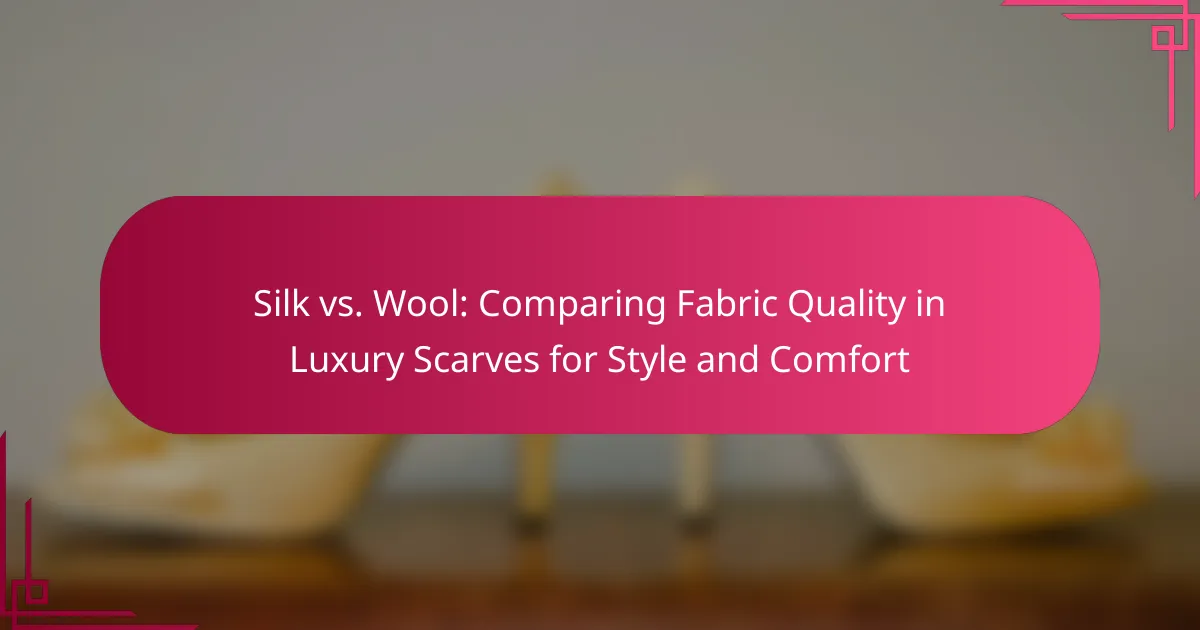Silk and wool are two distinct fabrics commonly used in luxury scarves, each offering unique qualities that cater to different preferences and needs. Silk is characterized by its smooth, lightweight texture and natural sheen, making it ideal for formal occasions and warmer weather. In contrast, wool provides thicker insulation and warmth, making it suitable for colder climates and casual wear. The article explores the differences in texture, durability, care requirements, and price points between silk and wool, helping readers make informed choices based on their personal style and comfort preferences. Additionally, factors such as allergies and fashion trends are considered in the decision-making process for selecting between these two luxurious fabrics.

What are the key differences between silk and wool in luxury scarves?
Silk and wool differ significantly in luxury scarves. Silk is smooth, lightweight, and has a natural sheen. It provides a luxurious feel against the skin. Wool, on the other hand, is thicker and offers warmth and insulation. It has a more textured surface compared to silk.
Silk scarves drape elegantly and are often used for formal occasions. Wool scarves are more casual and suitable for colder weather. Silk absorbs moisture but dries quickly, while wool retains heat even when wet.
Silk is made from silkworm fibers, while wool comes from sheep. The production processes for both materials are distinct. Silk is often more expensive due to its labor-intensive production. Wool is generally more durable and can withstand wear over time.
Both fabrics have unique care requirements. Silk needs gentle washing and can be damaged by heat. Wool is more resilient but may require special cleaning to avoid shrinkage.
How do silk and wool compare in terms of comfort?
Silk is generally considered more comfortable than wool. Silk has a smooth texture that feels soft against the skin. It is lightweight and breathable, providing a luxurious sensation. Wool, while warm, can be coarse and irritating for some individuals. It is also heavier and less breathable compared to silk. Studies show that silk’s natural properties help regulate temperature, enhancing comfort in various climates. In contrast, wool may cause itching for sensitive skin types. Therefore, for overall comfort, silk is typically preferred over wool.
What specific qualities of silk contribute to its comfort?
Silk is known for its exceptional comfort due to several specific qualities. First, silk has a smooth texture that feels soft against the skin. This smoothness reduces friction, preventing irritation. Second, silk is breathable, allowing air circulation that helps regulate body temperature. This property keeps the wearer cool in warm conditions and warm in cooler conditions. Third, silk has natural moisture-wicking abilities, which draw moisture away from the skin. This feature keeps the wearer dry and comfortable. Additionally, silk is lightweight, contributing to a feeling of ease when worn. Lastly, silk has a natural elasticity, allowing it to drape beautifully without feeling restrictive. These qualities collectively enhance the comfort of silk garments.
What specific qualities of wool contribute to its comfort?
Wool is known for its exceptional comfort due to several specific qualities. Its natural elasticity allows wool fibers to stretch without losing their shape. This elasticity contributes to a comfortable fit when worn. Wool also has moisture-wicking properties, which help regulate body temperature by absorbing and releasing moisture. This keeps the wearer dry and comfortable in various conditions. Additionally, wool is breathable, allowing air circulation while providing insulation. The soft texture of fine wool varieties, such as Merino, enhances comfort against the skin. Lastly, wool has natural crimp, which creates insulating pockets of air, further contributing to warmth without bulk. These qualities collectively make wool a preferred choice for comfort in luxury scarves.
What are the aesthetic qualities of silk compared to wool?
Silk has a smooth, lustrous appearance, while wool has a more textured, matte finish. Silk reflects light beautifully, creating a shiny surface that enhances its visual appeal. In contrast, wool absorbs light, resulting in a softer, more muted look. Silk drapes elegantly, allowing it to flow and shape effortlessly around the body. Wool, however, provides structure and warmth, making it ideal for creating cozy garments. The color vibrancy in silk is often more intense due to its fiber composition, while wool tends to have a more subdued color palette. These aesthetic differences make silk suitable for formal occasions and wool for casual wear.
How does the sheen of silk affect its visual appeal?
The sheen of silk significantly enhances its visual appeal. This characteristic gives silk a luxurious and elegant appearance. The natural luster reflects light beautifully, creating a rich, vibrant look. This sheen can vary based on the weave and finish of the silk. For example, satin silk has a high sheen, contributing to its glamorous aesthetic. In contrast, matte silk has a subtler appearance but still retains elegance. The visual impact of silk’s sheen makes it a preferred choice for luxury scarves. Studies show that consumers often associate sheen with quality and sophistication in fabrics.
What textures and patterns are commonly found in wool scarves?
Wool scarves commonly feature textures such as ribbed, cable knit, and felted. These textures provide warmth and a cozy feel. Patterns frequently found include houndstooth, plaid, and stripes. Houndstooth offers a classic, timeless design. Plaid provides a versatile option suitable for various styles. Stripes can add a modern touch to wool scarves. The combination of these textures and patterns makes wool scarves popular for both functionality and fashion.
How do the durability and maintenance of silk and wool differ?
Silk is generally less durable than wool. Silk can be prone to tearing and damage from sunlight. It requires careful handling to maintain its appearance. Wool, on the other hand, is more resilient and can withstand wear and tear. Wool fibers have natural elasticity, allowing them to recover from stretching. Maintenance for silk involves gentle washing and avoiding harsh chemicals. Wool is easier to care for and often machine washable. This difference in durability and maintenance makes wool a practical choice for everyday use.
What care instructions are recommended for silk scarves?
Silk scarves should be hand-washed or dry-cleaned for proper care. Use cold water and a gentle detergent if washing by hand. Avoid wringing or twisting the fabric to prevent damage. Rinse thoroughly and lay flat to dry away from direct sunlight. Iron on a low setting if needed, using a cloth between the iron and the scarf. These methods help maintain the silk’s luster and prevent shrinkage.
What care instructions are recommended for wool scarves?
Wool scarves should be hand washed in cold water with a gentle detergent. Avoid using hot water as it can shrink the fibers. After washing, do not wring or twist the scarf; instead, lay it flat on a clean towel to dry. This helps maintain its shape and texture. Avoid hanging wool scarves, as this can stretch the fabric. Store them in a cool, dry place, preferably folded to prevent creasing. Using moth repellents can also help protect the scarf from damage. These care instructions help ensure the longevity of wool scarves.

What factors should be considered when choosing between silk and wool scarves?
When choosing between silk and wool scarves, consider factors such as texture, warmth, and care requirements. Silk scarves offer a smooth, luxurious feel and are lightweight. They are ideal for warmer weather or layering. Wool scarves provide insulation and are better for cold climates. They are thicker and can be scratchier against the skin.
Durability is another factor; wool is generally more resilient and resistant to wear. Silk can be delicate and may require more careful handling. Additionally, consider the price point; silk tends to be more expensive due to its production process. Lastly, think about the intended use; silk is great for formal occasions, while wool is suitable for casual wear.
How do the seasons influence the choice of silk or wool?
The seasons significantly influence the choice between silk and wool due to their distinct properties. Silk is lightweight and breathable, making it ideal for warmer seasons. It provides a cooling effect, which is beneficial during spring and summer. In contrast, wool is heavier and offers insulation, making it suitable for colder seasons. It retains heat, providing comfort in autumn and winter. The texture of silk feels smooth against the skin, which is preferable in hot weather. Wool’s natural elasticity and moisture-wicking properties help maintain warmth and dryness in colder conditions. Seasonal temperature variations dictate the fabric’s suitability for comfort and style in luxury scarves.
What are the benefits of wearing silk scarves in warmer weather?
Wearing silk scarves in warmer weather offers several benefits. Silk is a lightweight and breathable fabric. It helps regulate body temperature, keeping you cool. Silk also has moisture-wicking properties, absorbing sweat without feeling heavy. Additionally, silk scarves provide UV protection from harmful sun rays. They can be styled in various ways, adding elegance to summer outfits. The smooth texture of silk feels comfortable against the skin. Furthermore, silk is less likely to irritate sensitive skin compared to other fabrics. These qualities make silk scarves an ideal choice for warm climates.
What are the benefits of wearing wool scarves in colder weather?
Wearing wool scarves in colder weather provides excellent insulation and warmth. Wool fibers trap heat while allowing moisture to escape. This keeps the wearer dry and comfortable. Wool is also naturally breathable, preventing overheating. Additionally, wool is resistant to wind, providing protection against chilly gusts. The durability of wool ensures long-lasting wear even in harsh conditions. Furthermore, wool scarves often have a soft texture, enhancing comfort against the skin. Studies show that wool can maintain warmth even when wet, making it a reliable choice for cold climates.
What styles and occasions are best suited for silk vs. wool scarves?
Silk scarves are best suited for formal occasions and stylish outfits. They add elegance and sophistication to evening wear and business attire. Silk’s smooth texture and sheen enhance the overall look. Wool scarves, on the other hand, are ideal for casual and outdoor settings. They provide warmth and comfort during colder months. Wool is often paired with winter coats and casual sweaters. Silk is favored for events like weddings and galas. Wool is preferred for everyday wear and outdoor activities.
How can silk scarves enhance formal attire?
Silk scarves enhance formal attire by adding elegance and sophistication. The smooth texture of silk complements formal fabrics like suits and dresses. Silk’s natural sheen creates a luxurious appearance, elevating overall style. Additionally, silk scarves can be styled in various ways, offering versatility in presentation. They can be tied around the neck, draped over the shoulders, or used as hair accessories. The lightweight nature of silk ensures comfort while maintaining a polished look. Historical fashion trends highlight silk scarves as a staple in formal wear for both men and women.
What casual looks can be complemented with wool scarves?
Wool scarves can complement various casual looks. They pair well with denim jackets for a laid-back style. Wool scarves also enhance the warmth of a simple t-shirt and jeans combination. Layering a wool scarf over a hoodie adds texture and comfort. Wool scarves can elevate a casual dress, providing a cozy touch. They work effectively with casual outerwear, like parkas or puffer jackets. Wearing a wool scarf with chinos offers a smart-casual vibe. A wool scarf can also be styled with knitwear for a cohesive winter look.

What are the personal preferences that affect the choice between silk and wool?
Personal preferences that affect the choice between silk and wool include texture, warmth, and maintenance. Silk is often preferred for its smooth, luxurious feel against the skin. Many individuals choose silk for its lightweight and breathable qualities. Wool, on the other hand, is favored for its warmth and insulation properties. People often select wool for colder climates or winter wear. Allergies also play a role; some may have sensitivities to wool but not to silk. Additionally, ease of care influences choices; silk typically requires more delicate handling than wool. Fashion trends may also sway preferences, as certain styles favor one fabric over the other. Personal style and comfort are key factors in this decision-making process.
How does personal style influence the decision between silk and wool?
Personal style significantly influences the choice between silk and wool. Individuals with a preference for elegance and luxury often gravitate towards silk. Silk is known for its smooth texture and sheen, which enhance sophisticated outfits. On the other hand, those who favor a more casual or rustic aesthetic may prefer wool. Wool offers warmth and texture, aligning with a cozy, laid-back style. Additionally, personal style can dictate the occasion for wearing these fabrics. Formal events typically call for silk, while everyday wear may favor wool. Ultimately, the decision is guided by how each fabric complements an individual’s unique fashion identity.
What fashion trends favor silk scarves?
Current fashion trends favor silk scarves due to their versatility and elegance. Silk scarves can be styled in numerous ways. They can be worn as headbands, neckties, or bag accessories. This adaptability enhances their appeal in various fashion contexts. Additionally, the luxurious feel of silk complements both casual and formal outfits. Designers frequently incorporate silk scarves into runway shows. The trend aligns with a growing emphasis on sustainable and high-quality materials in fashion. Silk’s natural sheen adds visual interest to ensembles, making it a popular choice among fashion influencers.
What fashion trends favor wool scarves?
Current fashion trends favor wool scarves for their versatility and warmth. Wool scarves are popular in layering outfits during colder months. They complement oversized coats and chunky knitwear effectively. Streetwear styles often incorporate wool scarves for added texture. Additionally, sustainable fashion trends promote wool as an eco-friendly choice. Designers highlight wool’s durability and timeless appeal. Seasonal collections frequently showcase wool scarves in various patterns and colors. Fashion influencers advocate for wool scarves as essential winter accessories.
What practical tips can help in selecting the right luxury scarf?
Choose a luxury scarf based on fabric quality, style, and versatility. Consider silk for its softness and sheen. Silk scarves provide a luxurious feel and drape well. Wool offers warmth and durability, ideal for colder climates. Evaluate the scarf’s size; larger scarves can be styled in multiple ways. Check the craftsmanship; hand-stitched edges indicate higher quality. Assess color and pattern; choose what complements your wardrobe. Lastly, consider the brand’s reputation for luxury and quality. These factors ensure a satisfying purchase.
How can one assess the quality of silk and wool scarves before purchasing?
To assess the quality of silk and wool scarves before purchasing, examine the fabric’s feel, appearance, and construction. High-quality silk should feel smooth and soft against the skin. Authentic silk has a natural sheen and vibrant colors. Wool scarves should feel warm yet breathable, with a slight elasticity. Check for any pilling or roughness, which indicates inferior quality. Inspect the stitching; high-quality scarves have even, tight seams without loose threads. Look for labels that indicate the fabric’s composition, ensuring it is 100% silk or wool for the best quality.
What are the common misconceptions about silk and wool scarves?
Common misconceptions about silk and wool scarves include the belief that silk is always more expensive than wool. While silk can be costly, high-quality wool scarves can also be expensive due to the rarity of fine wool. Another misconception is that wool is always itchy and uncomfortable. Many modern wool scarves are treated for softness and comfort. Additionally, some people think silk is not warm enough for winter wear. In reality, silk can provide warmth due to its natural insulation properties. Lastly, there is a belief that wool requires excessive care. Many wool scarves are now machine washable and easy to maintain, debunking this myth.
The main entity of this article is luxury scarves, specifically focusing on the comparison between silk and wool fabrics. Key differences between silk and wool include texture, warmth, durability, and maintenance, influencing their suitability for various occasions and seasons. Silk is lightweight and smooth, ideal for formal settings and warmer weather, while wool offers insulation and durability, making it preferable for casual wear in colder climates. The article also addresses comfort, aesthetic qualities, and care instructions for both materials, along with personal preferences that affect the choice between silk and wool scarves.
